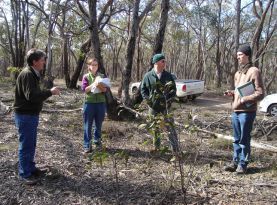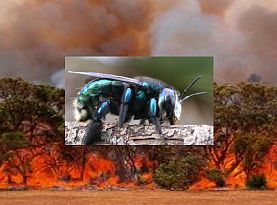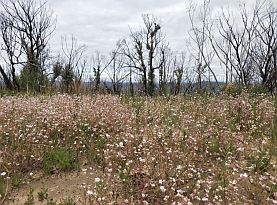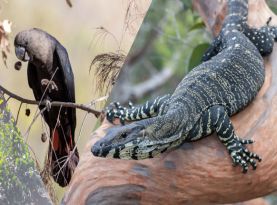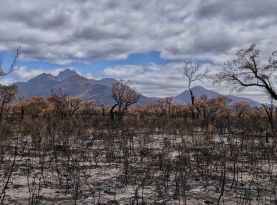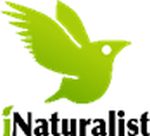SWIFFT Seminar notes 25 March 2021
Fire recovery and Citizen Science
SWIFFT seminar notes are a summary of the seminar and not intended to be a definitive record of presentations made and issues discussed.
This SWIFFT seminar was conducted online with 84 participants via Microsoft Teams and streamed live via YouTube. SWIFFT wishes to acknowledge support from the Department of Environment, Land, Water and Planning, Victoria in organising the seminar and thank speakers for their time and delivery of presentations. Thanks to Michelle Butler who chaired the session from Ballarat and acknowledged the Elder’s past and present on the lands covered by the meeting.
Key points summary
Conservation of the Green Carpenter Bee - fire recovery and citizen science
- The Green Carpenter Bee is an iconic native species found only in Australia but now extinct in Victoria and mainland South Australia.
- The only remaining populations are found the western end of Kangaroo Island, South Australia and areas near Sydney and northern New South Wales but their habitat was burnt in the 2019/20 bushfires.
- Citizen Scientists are helping to save the Green Carpenter Bee on Kangaroo Island though monitoring and installation of artificial nesting material.
Year of the Environment Recovery Project: Lessons Learned and Future Directions
- The Environment Recovery Project aims to monitor post bushfire recovery with Citizen Scientists using iNaturalist.
- Citizen Scientists are able to contribute a vast amount of information across a large geographic area in a very short timeframe.
- Citizen Scientists have helped map bushfire severity and re-discover species which had their habitat burnt.
- Pink Flannel Flower has a long dormancy with unique conditions for its flowering. It is now the third most observed species following the fires.
Bushfire Recovery- community wildlife reporting
- Due to the vast area of the fire, it is difficult to conduct surveys of the entire area but Citizen Science can play an important role in gaining a picture of biodiversity recovery post fire.
- To participate in the Community Wildlife Reporting Project simply record your observation by using apps such as iNaturalist, Vbago or Birdata.
- Focal species include some easily identified species; Koala, and Lace Monitor but also some more cryptic and difficult to identify species such as the Glossy Black-cockatoo, Diamond Python, Spot-tailed Quoll and Ground Parrot.
East Gippsland Regional Landcare – fire recovery and Landcare
- East Gippsland Landcare Network and Far East Victoria Landcare are collaborating on 15 fire related projects.
- Citizen Scientists are helping researchers to assess landscape-scale impacts of bushfires on platypus using environmental DNA (eDNA).
- Citizen Scientists are helping to save species such as the Buchan Blue Wattle, Glossy Black Cockatoo and Eastern Ground Parrot through raising community awareness and working with landholders on habitat conservation.
Citizen Science is good for you - being involved in nature recovery through projects like Citizen Science can be very beneficial for people to recover from fires. Nature-led recovery grants
List of speakers and topics
- Conservation of the Green Carpenter Bee and the role of citizen science - Richard Glatz, Visiting Research Fellow - University of Adelaide
- A Year of the Environment Recovery Project: Lessons Learned and Future Directions - Casey Kirchhoff, PhD candidate - Centre for Ecosystem Science, School of Biological, Earth & Environmental Science, UNSW
- Bushfire Recovery- community wildlife reporting - Hayley Ricardo, Natural Environment Project Officer - Department of Environment, Land, Water and Planning, Gippsland Region
- East Gippsland Regional Landcare – fire recovery and Landcare - Matt Stephenson, Project Manager - East Gippsland Landcare Network, Josh Griffiths, Senior Wildlife Ecologist at Enviro DNA and Penny Gray, Network Coordinator - Far East Victoria Landcare
Speaker summaries
Conservation of the Green Carpenter Bee and the role of citizen science
Richard Glatz, Visiting Research Fellow - University of Adelaide and Principal Scientist & Founder, D'Estrees Entomology & Science Services.
Richard has undertaken research on the Carpenter Bee on Kangaroo Island since 2013. Richard’s presentation highlights the role Citizen Science can play in the conservation of often little known yet highly vulnerable native species. Richard reminded us that invertebrates are 95% of the biodiversity of animals on the land yet they have a much lower profile/priority than birds and mammals.
Introduction to Carpenter Bees (Xylocopa spp.)
Richard gave a brief overview of Carpenter Bees, named because they excavate their own nests in wood. There are over 750 species of Carpenter Bees worldwide. Carpenter Bees use a variety of wood types and plant species to nest and for nutrition. The Green Carpenter Bee Xylocopa aerate is only found in Australia and utilises pithy soft wood in native vegetation for nests.
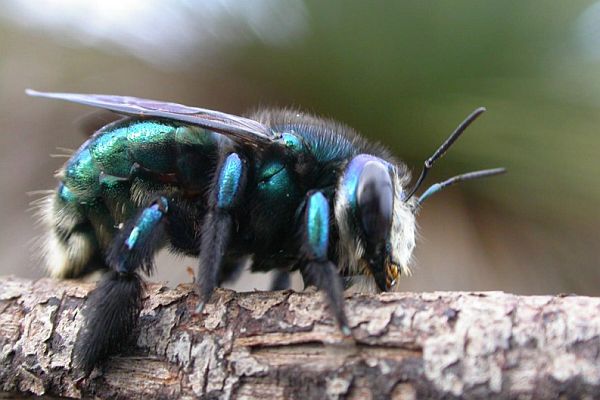
The Green Carpenter Bee is referred to as a buzz pollinator, unlike pollination by a honey bee which moves available pollen from one flower to another. Many Australian native plants need to be vibrated at a specific frequency which triggers the plant to expel its pollen. Honey bees do not buzz pollinate and are poor pollinators of many Australian native plants.
Female Green Carpenter Bee foraging on Leptospermum continentale , Kangaroo Island 14th December 2020. Source: Richard Glatz.
Life cycle
The Green Carpenter Bee has an annual life cycle with a low reproduction rate. Unlike the honey bee the Green Carpenter Bee does not form large nesting swarms. Adults emerge from nests and become active in Spring (October), after mating the males die around November. The females excavate nests and construct tunnels and brood chambers which contain pollen for the larvae to feed on (Dec-Feb). The female bee cares for her own brood in her own nest. The mother cares for the young bees and when they have fully developed, she dies. The young remain in the nest over winter and emerge in spring. In a good year only about 12 bees are raised per nest.
Contraction of range and extinctions
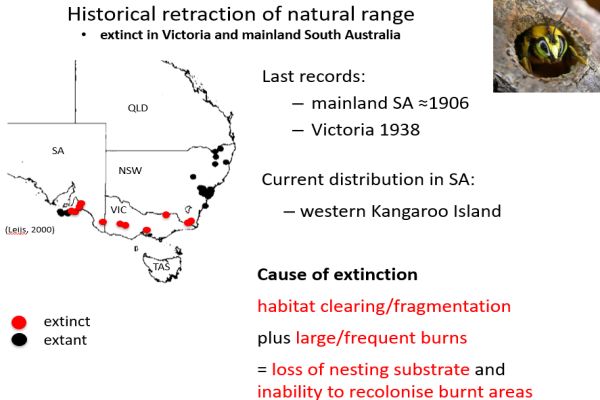
The Green Carpenter Bee has suffered a major reduction in its range and is now extinct in Victoria and mainland South Australia. The last records being 1938 in Victoria and 1906 in mainland South Australia.
The only remaining populations are on the western end of Kangaroo Island, South Australia and areas near Sydney and northern New South Wales. (Richard pointed out that most of the areas were burnt in the 2019/20 bushfires). In Victoria, the last records were in the Grampians in 1938, however the area was burnt in the 1939 fires and the carpenter bee has not been recorded in the Grampians since then.
Benefit and threats of fire
Richard spoke about the complex relationships between the Green Carpenter Bee and two of its primary nesting plants (Banksia and Grass Tree) and fire. The Carpenter Bee only nests in dead Banksia trunks and grass tree flower spikes after they have dried out. The grass tree flowers profusely after fire which can create new nesting substrate, however the dried out flower spikes of the grass tree and the dead banksia can readily burn resulting in loss of nesting substrate.
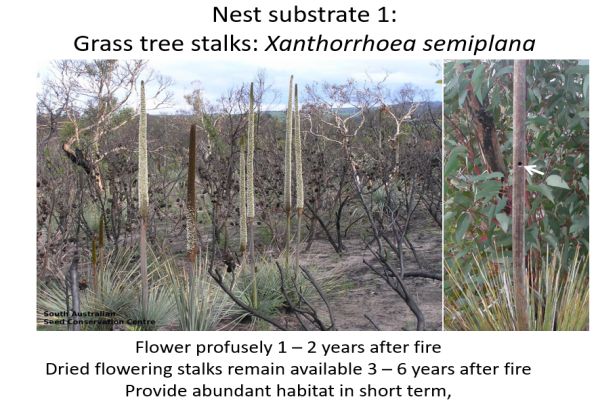
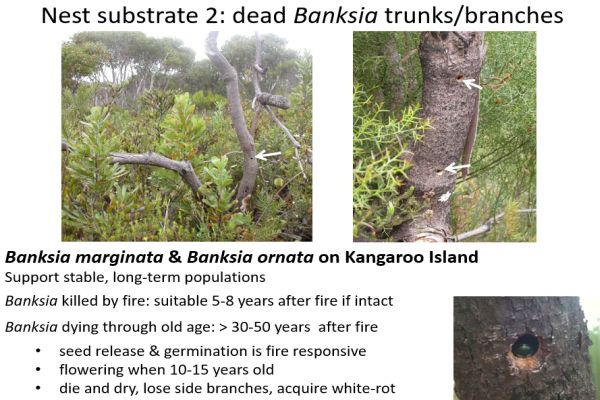
Surveys and Citizen Science
Richard spoke about surveys conducted in 2003 which found most of the Green Carpenter Bee populations were in the well vegetated western part of Kangaroo Island. Apart from Flinders Chase National Park much of the suitable habitat is fragmented containing more sparse records.
In 2007 a large fire burnt out much of the carpenter bee habitat. In 2013-14 further surveys were carried out with help from Citizen Scientists to determine the population status after the fire and the availability of nesting substrate (dead Banksias and Grass Tree flower spikes).
Citizen Science played a role in surveys and raising awareness about the Green Carpenter Bee in the community, which included an art exhibition focusing on the carpenter bee.
Results from the 2013-14 surveys
The Green Carpenter Bee had recolonized far into previously burnt areas of Flinders Chase National Park mainly due the prevalence of Grass Tree spikes. Some of the old Banksias had survived the 2007 fire which meant some source populations were present.
In the Flinders Chase National Park most of the banksias were burnt and the Grass Tree spikes had fallen over. Richard pointed out that it would be at least 25 to 30 years for Banksia to recover to a point where they would become suitable habitat.
Citizen Science helping to provide artificial Green Carpenter Bee nests.
Richard spoke about developing ways to provide artificial nesting substrate to enhance the carpenter bee population.
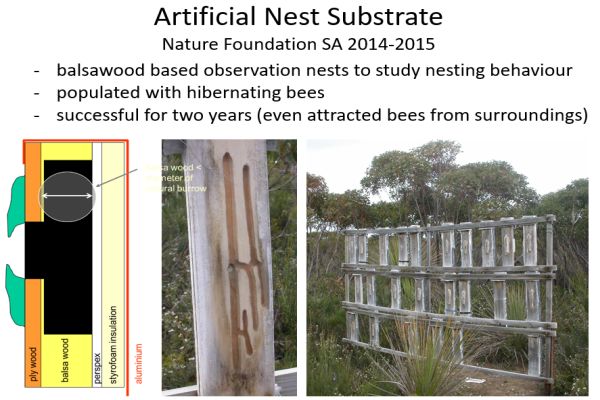
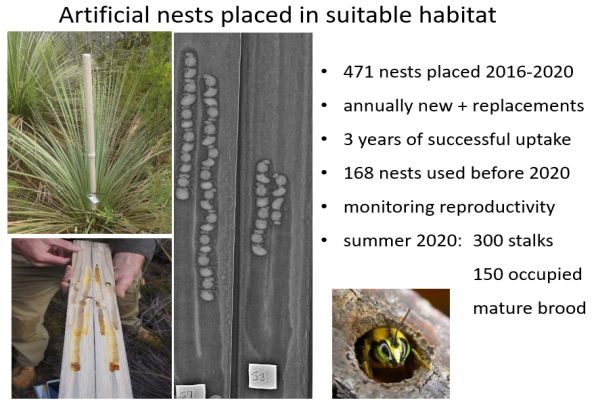
2019 – 2020 fires
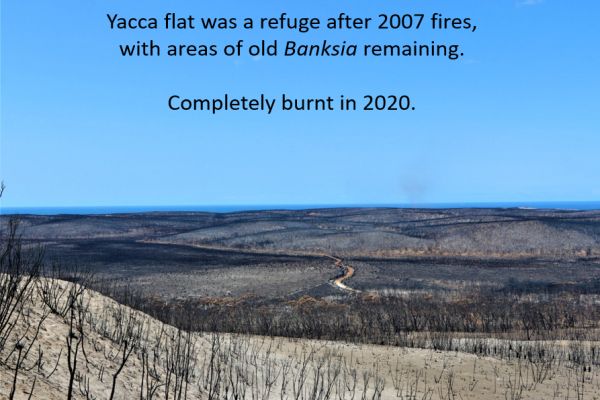
Richard described the devastation as a result of the high intensity bushfire and the loss of carpenter bee habitat including all 150 occupied artificial nesting stalks, all known Banksia nests and nearly all of the old Banksia country which could have provided nesting substrate which is now gone.
New surveys in January 2020 found 17 active nests at low densities in isolated locations which are fragmented from each other as the bees won’t cross unsuitable terrain.
Approximately 160 artificial spikes were installed at known locations for the bees to use in winter 2020 but there was no uptake. Richard felt the populations are so low that remnant nesting substrate may be sufficient at this time. There is now an abundance of Grass Tree spikes but these will disappear after 5-6 years. The larger issue is the loss of old Banksias which will take up to 50 years for the country to become useful for the carpenter bee.
Future activities
- Continue surveys (SA: DEW wildlife recovery)
- Look at installing nesting stalks on private property
- On-going community involvement and fundraising
- Assist recolonisation if needed (possible re-introduction into the Grampians)
- Monitor use of grass tree stalks
- Raise awareness:
- Managing the threat from prescribed burns
Richard touched on the balance between prescribed burns and ensuring adequate habitats remain, particularly given the extent of recent bushfires and extensive loss of habitat. Richard emphasised the importance of old forests, particularly those containing Banksia. There needs to be adequate recognition of fire-vulnerable species.
Continued fundraising for the Green Carpenter Bee
Donate to help save the Green Carpenter Bee
https://charity.gofundme.com/o/en/campaign/save-the-green-carpenter-bee
Acknowledgments
Richard acknowledged his colleagues and all the people who have contributed to the project aimed at saving the Green Carpenter Bee on Kangaroo Island.
Key points from questions
- Installation of artificial spikes will focus more on a time when the natural flower spikes begin to fall down in 3-5 years.
- One of the most important things people can do right now is to advocate for the conservation of bees in land management and consideration of bee habitat in fuel reduction programs.
- Conservation of remnant populations on private land requires community involvement in ensuring adequate nesting substrate and monitoring.
- Generally, carpenter bees are not found in the Allocasuarina vegetation as most of the Banksias are found on ironstone soils which do not support Allocasuarina.
- More research is required to better understand what constitutes a viable population and learn more about dispersal of the bee.
- Whilst the honey bee can be a positive species in an agricultural setting they can be regarded as a pest species in native environments as they can change the seed bank of the environment and directly compete with native bees.
- Land managers need to take account of the presence of the Green Carpenter Bee when planning fuel reduction burning by avoiding known locations.
See also: SWIFFT Seminar Notes 4 April 2019 – Native bees, wasps and ants
A Year of the Environment Recovery Project: Lessons Learned and Future Directions
Casey Kirchhoff, PhD candidate - Centre for Ecosystem Science, School of Biological, Earth & Environmental Science, UNSW
.jpg)
The Environment Recovery Project commenced in January 2020 with the goal of monitoring post bushfire recovery with help from Citizen Scientists.
Project platform
The project leveraged off iNaturalist which is an existing program linked with the Atlas of Living Australia.
Casey spoke about a relatively small learning curve for users who have never used an app-based Citizen Science project. To-date there are now 396 regular users, 13188 observations and 2322 species records.
Media campaign
An extensive media campaign was developed to promote the project and encourage users to contribute their observations. The media campaign was assisted through the UNSW media team and covered a range of print media, online, radio and even a TV segment. Casey felt the strong media uptake was driven by the fact that fires were still high in the community’s mind and people were looking for a positive action in the midst of the disaster.
Partnerships
The Environment Recovery Project has been added to the Australian Citizen Science Association and the CSIRO Project Finder web site which was set up not long after the fires as a platform whereby people interested in contributing to Citizen Science could select projects in which they had an interest.
Partnerships have also been formed with the Minderoo Foundation on their bushfire recovery project. https://www.minderoo.org/fire-and-flood-resilience/ and the Sydney Science Trail which targets school aged children to contribute to Citizen Science.
Project usage
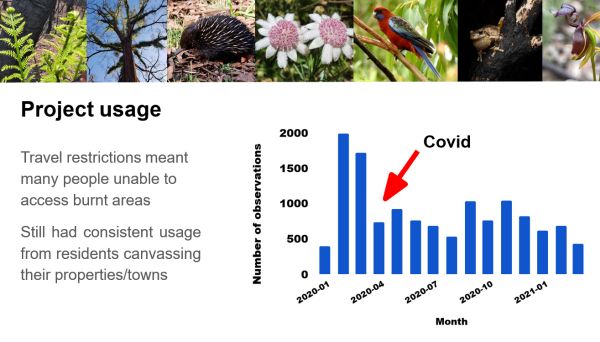
Casey pointed out the rapid uptake of users contributing to the project after its launch in January 2020 but unfortunately this declined rapidly with Covid travel restrictions, particularly from those travelling out into regional bushfire areas. Casey mentioned the dedicated long-term contributors who were able to maintain observations in their local area or on their own properties.
Examples of Citizen Science contributions
Determining the severity of the burn in the landscape
Citizen Scientists were able to rate the fire severity based on observed burn characteristics such as how high the burn went up the tree and the level of leaf scorch. Casey pointed out that in high severity burn areas, Citizen Science data was found to be very accurate when paired up with satellite imagery heat data mapping.
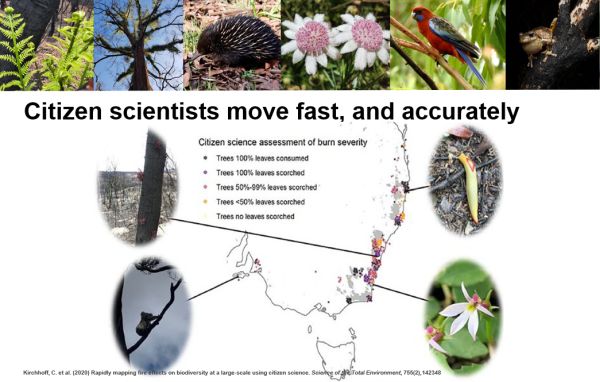
Re-discovering species
Casey highlighted research from the fires which found 100 plant species had their entire known range burnt (Godfree et al. 2021). Through the Environment Recovery Project, Citizen Scientists had played a role re-discovering species such as the Midge Orchid.
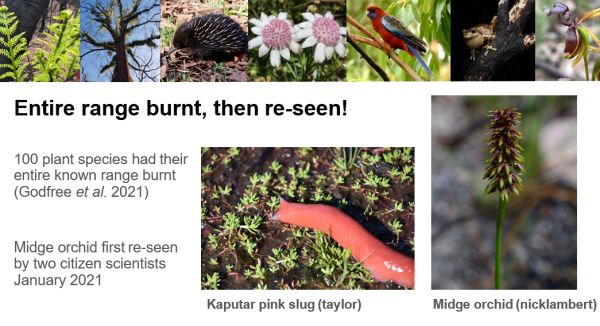
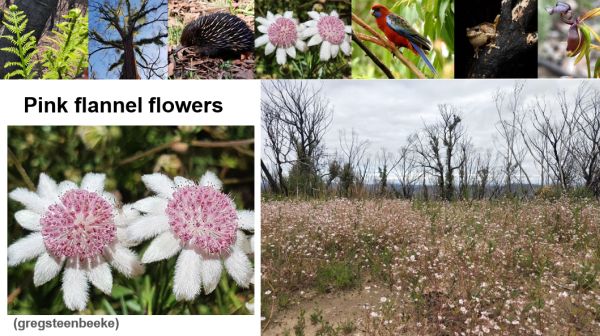
More informatiuon: Implications of the 2019–2020 megafires for the biogeography and conservation of Australian vegetation findings from Citizen Scientists (Godfree et al. 2021).
Future directions
Although the project was set up in response to the 2019/20 bushfires it is now open to all bushfire observations - before and after the 2019-2020 mega fires.
The project is intending to target surveys for rare species, or in Endangered Ecological Communities e.g., surveys in areas where the entire range of a species was burnt out.
During 2021 the project team intend to increase community engagement by getting out into bushfire areas and speak face-to-face with communities.
Develop more activities for school-aged children in bushfire areas.
More infromation: iNaturalist – Environment Recovery Project: Australian Bushfires
Contact Casey Kirchhoff also @alpine_flora_of_australia
Bushfire Recovery- community wildlife reporting
Hayley Ricardo, Natural Environment Project Officer - Department of Environment, Land, Water and Planning, Gippsland Region
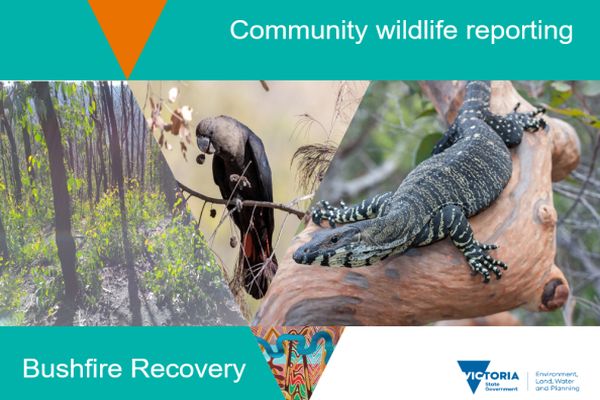
Haley works in the Bushfire Biodiversity Response and Recovery Team (BBRR) based at Bairnsdale with her role covering East Gippsland. The BBRR team is dedicated to flora and fauna monitoring and threat mitigation work across the bushfire zone. Some of the projects include targeted surveys of birds, mammals, bats, frogs, invertebrates and other species to gain an understanding of numbers surviving since the fires and recovery over time. Threat mitigation involves pest plant and animal control activities.
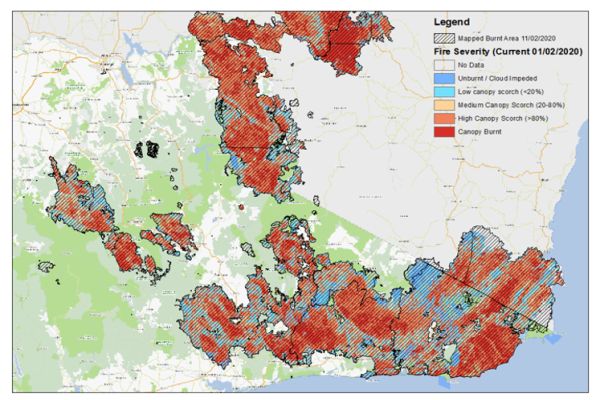
Community wildlife reporting
Haley spoke about the important role that people in the community can play as they are out and about in their daily lives by reporting wildlife sightings of six focal species. In particular, people that either live in the area or who may have visited the area over many years often have a connection and familiarity with what was there pre-fire and changes that have happened over time.
Focal species
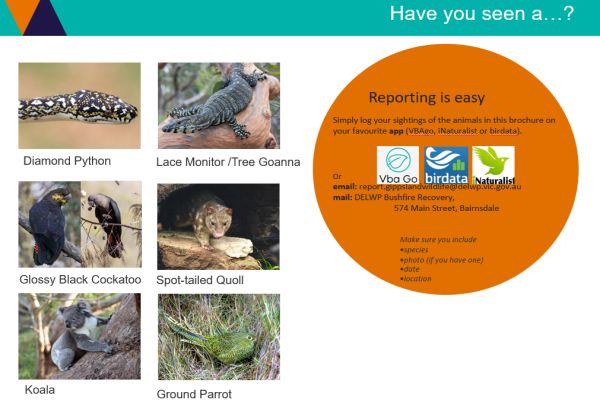
The 6 focal species include some well-known and readily distinguishable species such as the Koala, and Lace Monitor but also some more cryptic and difficult to identify species such as the Glossy Black-cockatoo, Diamond Python, Spot-tailed Quoll and Ground Parrot. Hayley pointed out that it is difficult to undertake systematic surveys of the more cryptic species but the more eyes and ears on the ground via the community the more chance there is of finding them, monitoring their health and protecting their habitat.
Reporting platforms
- iNaturalist – great ID tool
- Birdata familiar to people with a bird interest
- Vbago (Victorian focused biodiversity atlas)
- Or email using report.gippslandwildlife@delwp.vic.gov.au
The value of community reporting
Hayley emphasised the role and importance of community wildlife reporting. Sightings can directly contribute to ongoing monitoring and management work by identifying target areas and maximising the use of resources.
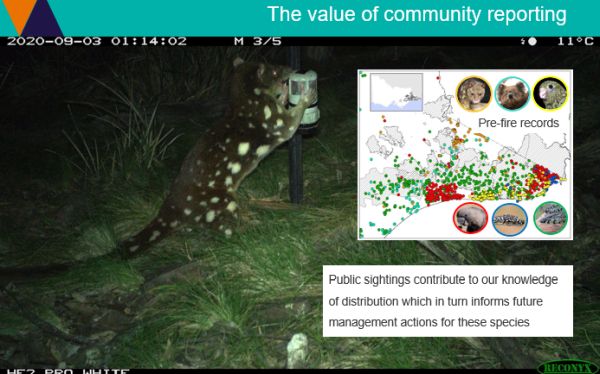
As an example, Hayley spoke about Spot-tailed Quoll camera surveys in targeted areas which have been repeated over a number of years. Prior to the fires, surveys indicated a declining population trend. Post fire surveys in previously known quoll habitat show a worsening trend with 104 cameras detecting only 2 Spot-tailed Quolls. A Spot-tailed Quoll sighting reported via community wildlife reporting has been very important as it helps the team to learn more about post fire occurrence outside where they had been surveying.
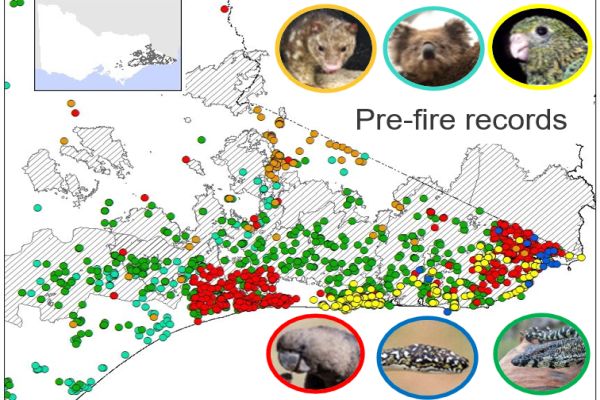
Hayley spoke about some of the records that have come in via Community Wildlife Reporting since the fires. There have been quite a few reports of the Lace Monitor with supporting images which is very encouraging to know this species is observed post fire. Important records of the Diamond Python at Mallacoota have also been received.
More information
Community Wildlife Reporting project
Send in a sighting via direct e-mail report.gippslandwildlife@delwp.vic.gov.au
Brochures and A3 and A4 posters are also available on request.
Reporting is easy
Simply log your sightings of wildlife in bushfire affected areas on any one of these apps
Acknowledgements
Hayley acknowledged the positive contribution from people involved in the project. The work is funded through the Victorian Government’s $17.5 million funding package to assist Phase 1 of the Bushfire Biodiversity Response and Recovery program. The BBRER Program provides funding for immediate relief and early recovery to species and ecological communities most at-risk from the impacts of the 2019-20 Victorian bushfires.
Key points from questions
- Additional species will not be included in the project at this time due to resourcing but people can still report any species via iNaturalist and Vbago.
- East Gippsland is the stronghold for Ground Parrot in Victoria but unfortunately the bushfires burnt out most of the suitable heathland habitat. There have been some post fire records which indicate they still exist in the area but probably at much lower numbers.
- The heavy rain post fire has presented issues with erosion and siltation of rivers.
East Gippsland Regional Landcare – fire recovery and Landcare
Matt Stephenson, Project Manager - East Gippsland Landcare Network
Josh Griffiths, Senior Wildlife Ecologist at Enviro DNA
Penny Gray, Network Coordinator - Far East Victoria Landcare
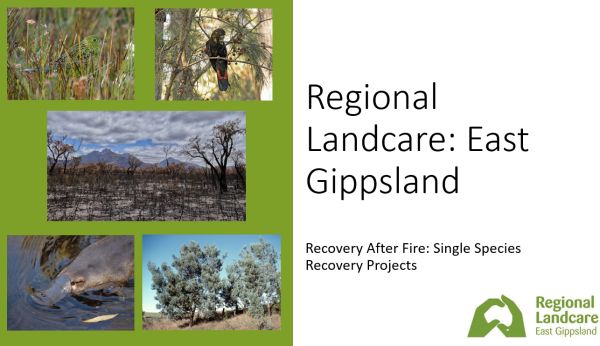
Matt introduced the presentation and acknowledged traditional owners of the land. East Gippsland Landcare Network (EGLN) and Far East Victoria Landcare (FEVL) are collaborating on 15 fire related projects amongst other projects. East Gippsland Regional Landcare supports 29 Landcare and ‘Friends of’ Groups in East Gippsland.
Following the 2019/20 bushfires, species specific projects are underway to enable the recovery of:
- Platypus (EGLN/EnviroDNA)
- Buchan Blue Wattle (EGLN)
- Glossy Black Cockatoo (FEVL)
- Eastern Ground Parrot (FEVL)
These projects are funded through the Victorian Government’s Biodiversity Bushfire Recovery Grants.
Josh Griffiths, Senior Wildlife Ecologist at Enviro DNA
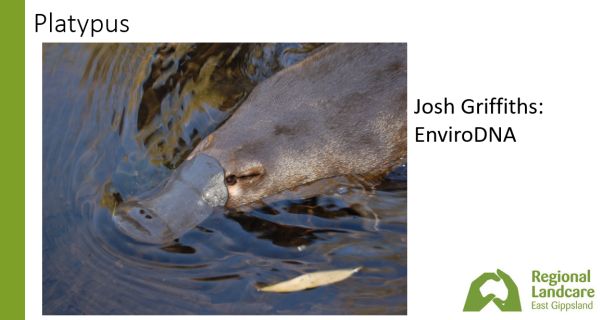
Josh Griffiths from EnviroDNA spoke about the Platypus Project which is aimed at understanding the impact of bushfire on platypus. The direct impact on platypus from fires has not been considered a major threat in the past but the scale of the 2019/20 fires meant that vast areas of waterways were be impacted through ash and sediment being washed into streams degrading platypus habitat and impacting on populations over an entire region.
In order to assess landscape-scale impacts of bushfires on platypus the project is using environmental DNA (eDNA) and citizen scientists. Josh explained that by taking water samples and looking for traces of platypus DNA the team can determine if platypus are present with a high level of confidence.
The community is engaged in Citizen Science through the water sampling, with 100 sites across East Gippsland. The first stage of sampling involved 38 volunteers who took water samples from 100 sample sites covering 6 river basins.
Covid presented some issues but also encouraged the development of achieving the water samples using remote training of volunteers and allocate streams to be samples and deliver samples by post.
Pre-fire and post fire sampling
Josh spoke about the value of pre-fire data on platypus in East Gippsland which assisted in targeting areas for surveys after the fires.
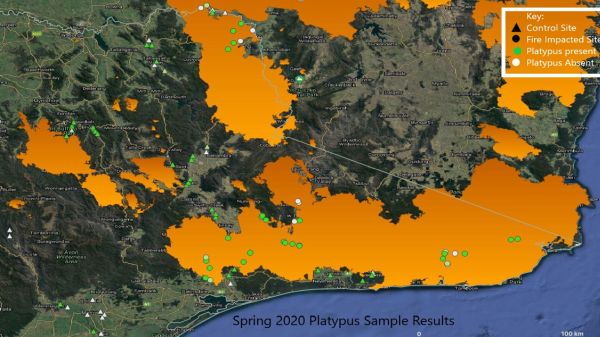
Josh highlighted that the citizen scientists undertaking water sampling have embraced the opportunity be involved in the project. The second round of testing begins soon. Josh also highlighted that Platypus are now listed as vulnerable in Victoria.
Matt Stephenson, Project Manager - East Gippsland Landcare Network
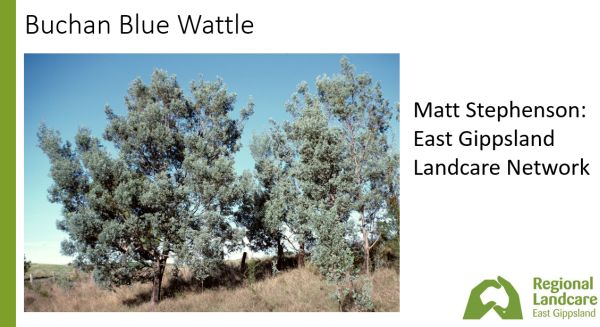
Matt spoke about an intensive project undertaken by East Gippsland Landcare Network focused on the Buchan Blue Wattle Acacia Caerulescens.
Buchan Blue Wattle only occurs naturally in very small populations in south-east Australia, predominately in the East Gippsland area. It grows to 10-15m and is largely found in remnant populations on clay over limestone. There were approximately only 1,700 plants prior to the fires. The species is listed as vulnerable.
Matt pointed out that the remaining stands, particularly in the vicinity of Buchan are considered a ‘site of Significance’ the area was heavily impacted by the 2019-20 fires. Although there has been some recent germination of new plants the concern is for protection and management of the remaining larger, seed producing specimens.
Objectives
- Restore the roadside site of significance
- Ensure additional colonies of Buchan Blue planted in ‘safer’ areas to ensure survival of species (800 BBW seedlings)
- Education – improve local & visitor knowledge now and into future with new signage and through local media
Matt pointed out that community involvement and partnerships are essential to the project. This includes; local Landcare groups, landholders, local school and kinder, volunteer groups, visitors to the Caves Reserve (planting in school holidays). It has been pleasing to see a number of new community groups interested and participating in the project. Partnerships with key stakeholders include; Regional Roads Victoria (RRV) and Parks Victoria.
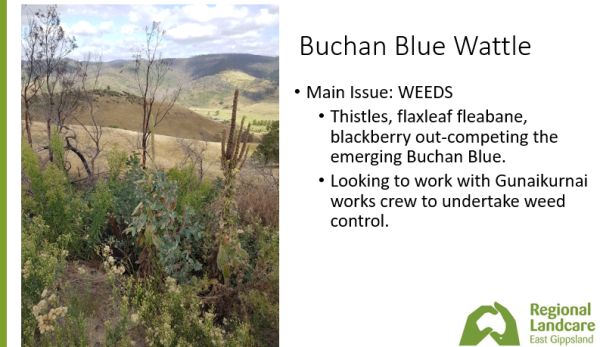
The project has raised the profile of the Buchan Blue Wattle in the community and resulted in partnerships with the National Parks Association in establishing a seed bank and seed collection training for volunteers in East Gippsland. Depletion of the natural seed resource could become a very real issue if there are more fires which burn remaining seed-bearing trees.
Penny Gray, Network Coordinator - Far East Victoria Landcare
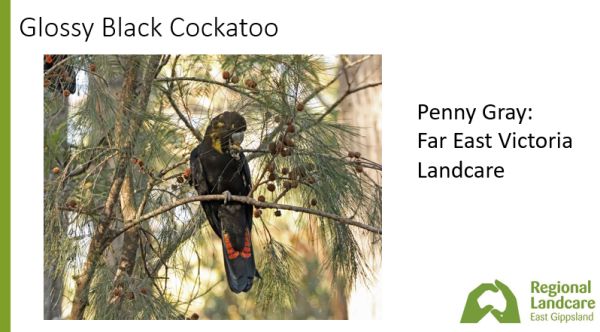
Penny introduced her presentation by talking about her communications with people impacted by fire and the concerns they raised over the welfare of wildlife. The project was developed to Improve the community’s familiarity with the project species.
Glossy Black Cockatoo Project Aims
- Developing Casuarina sanctuaries (food source for the Glossy Black-cockatoo), identify and protect hollow trees (nesting sites) on private land in the known distribution range from Lake Tyers to the border.
- Plant 7000 seedlings and 2km fencing, funded.
- The original project proposal included the development of a Citizen Science project but it was decided to build on the existing Community Wildlife Reporting Project.
Progress
Expressions of Interest forms have been developed and sent out via email and on the Landcare website. The project has been promoted through print and social media posts. The project was promoted at the Orbost Show Landcare Expo with both Birdlife and DELWP citizen science projects. 2000 Casuarina littoralis were given away to encourage habitat awareness.
Eastern Ground Parrot
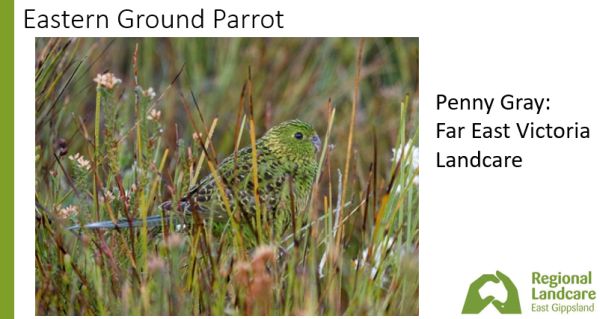
Penny spoke about the cryptic behaviour of the Eastern Ground Parrot and the fact that prior to the 2019/20 fires East Gippsland was the main stronghold for the species but the extent of the fires burnt much of the ground parrot’s habitat. It is therefore extremely important to involve the community in species awareness and the need to protect and restore habitat.
Project Aims
- To document suitable heathlands on private land on the Marlo Plains and survey for the presence of the Ground Parrot. This will be done in collaboration with Birdlife Australia research and a PhD research project
- Promote the vulnerability of the species and its existence
- Develop some guiding principles to enable landholders to protect their habitat
- A proposed stage 2 project to be focused on working with landholders who are willing to protect and managers in actively managing their heathlands
- Involve Citizen Science, Southern Farming Systems and Landcare
Ground Parrot art project
Penny highlighted a project which involved biodiversity art to raise awareness of the Citizen Science species.
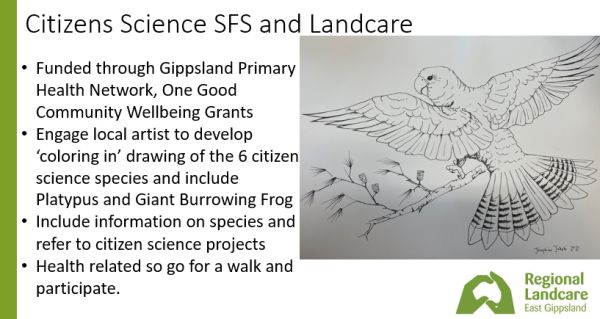
Video of Eastern Ground Parrot taken on the Marlo Plains by Vanessa Ingram Daniel. This species is incredibly difficult to observe under normal circumstances so it is quite remarkable to see the ground parrot moving through the grass and flying off. Source: Ground Parrot by Vanessa Ingram-Daniels from TopSoils & Landcare on Vimeo.
Citizen Science is good for you
Fern Hames from the Arthur Rylah Institute (ARI) recapped on the value of the Citizen Science projects presented in this seminar and the fact that research from the 2009 fires found that being involved in nature recovery through projects like Citizen Science can be very beneficial for people to recover from fires. Intentionally noticing nature can be incredibly good for a person’s wellbeing, it leads to connections with place, community and science. Fern stressed, Citizen Science can provide a sense of control and hope which can be extremely powerful in times of uncertainty and loss.
Nature-led community recovery project
This project is a partnership between ARI and Zoos Victoria. It will encourage forums in local areas and bring ARI scientists out into the Gippsland and North East communities so people can learn more about how they can help.
Small grants open 13 April 2021 - help share stories about connecting communities with nature led recovery.
Nature-led Recovery Grants poster
See also on the SWIFFT web site:
View notes from previous SWIFFT seminars
Citizen Science - learn more about apps and websites
Bushfire Recovery - community wildlife reporting


